Love a good savory pancake? This Korean Pancake (Pajeon 파전) recipe with scallion and shrimp is absolutely delicious! Enjoy it with my spicy soy dipping sauce.
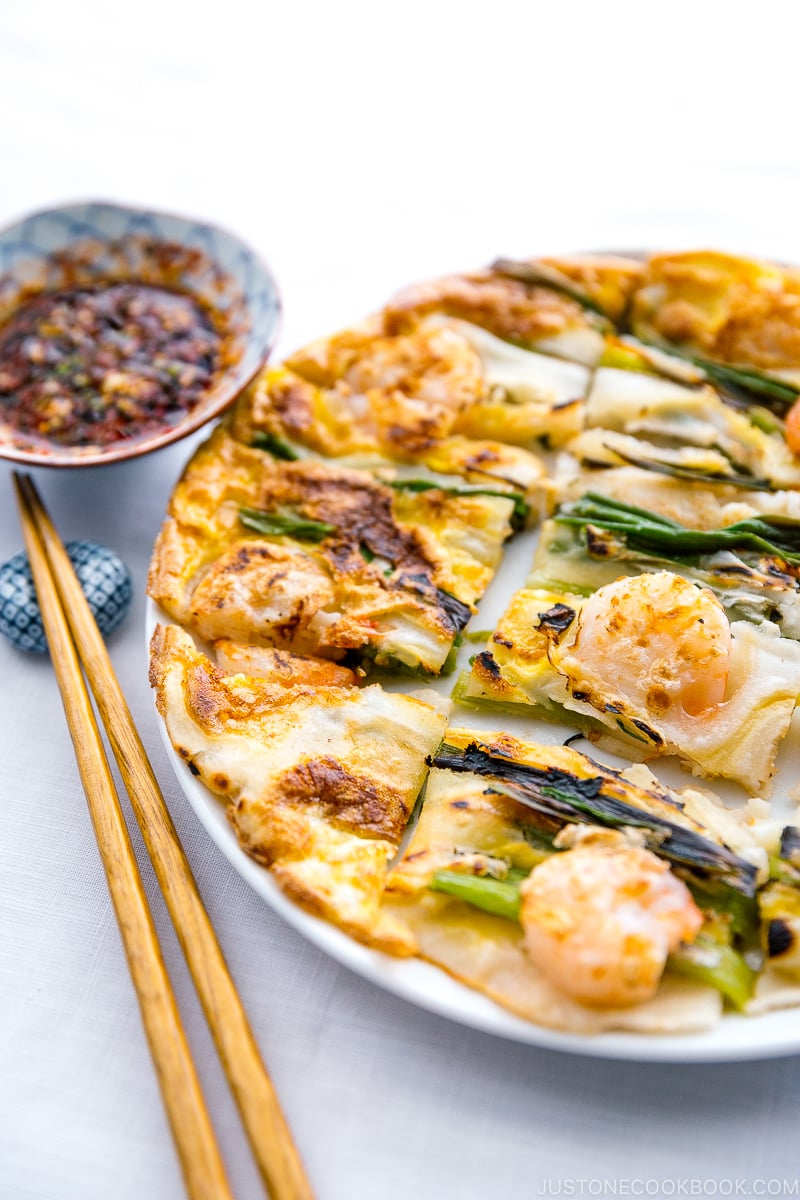
My family loves Korean food and when we go out to Korean restaurants, we always fight over the last piece of our favorite Korean pancake or pajeon. These crispy green onion pancakes are seriously quite addicting!
We like to eat pajeon as a side dish or afternoon snack, but it could make a delicious main dish as well. I sometimes make them for the kids before we head out to their after-school activities. They love hanging out in the kitchen to watch how I make these pancakes. Today, I’ll share the version that I make at home in my crispy and savory Korean Pancake recipe.
Table of Contents
What is Korean Pancake (Pajeon)?
Pajeon (파전) or pa jun is a type of savory Korean pancake that features scallion as the prominent ingredient. For the main protein, it often has shellfish and seafood like shrimp, squid, oysters, clam, and/or mussels, or a combination for a Korean seafood pancake. Beef, pork, and/or kimchi are other possible toppings. A vegetarian version could include vegetables like shredded carrots and zucchini.
The pancake is bound by a light batter and drizzled with beaten egg, then pan-fried until golden brown on both sides. It’s cut into bite-size squares and dipped in a Korean pancake sauce of soy sauce, rice vinegar, and sugar. You can customize the sauce with minced garlic, sesame oil, sesame seeds, fresh chili or dried chili flakes, and chopped green onions.
What is jeon? Korean pancake or jeon (pan-fried battered food in Korean) uses a cooking method where the vegetables and protein are placed in the frying pan one at a time. They may be dipped in the batter beforehand or drizzled with batter once they are in the pan. Jeon is a very popular food in Japan, and it goes by a different name called chijimi (チヂミ).
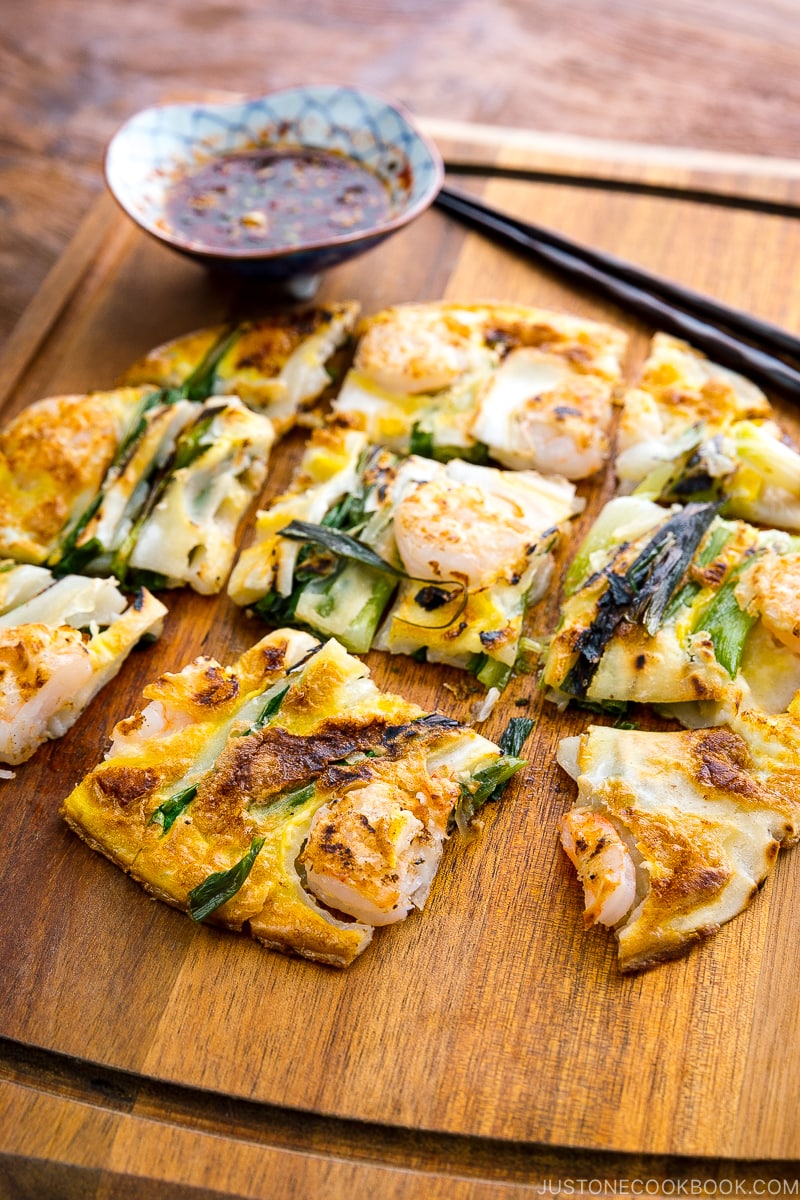
The Secret To Pajeon’s Unique Texture
For this green onion pancake, I used cake flour (薄力粉) instead of all-purpose flour. Cake flour is wheat flour that has a lower viscosity and protein content. My Korean friend suggested using it instead of plain flour, and the result was just like a restaurant pajeon! The texture is crispier and lighter than using all-purpose flour.
Cake flour is available in the bakery section of supermarkets. You can also make cake flour at home by mixing all-purpose flour and cornstarch. It’s super easy! I explain how in the Notes at the end of the recipe card.
My mom recently shared another recipe with me that uses all-purpose flour and rice flour, and she said it’s pretty amazing. I’ll be testing her recipe next time. You can also make a gluten-free version, like my Gluten-Free Korean Veggie Pancake.
Ingredients You’ll Need
For the Pancake
- green onions/scallions
- large egg – beaten; use half an egg per pancake
- shrimp – omit for vegetarian and use mushrooms
- cake flour – weigh your flour with a kitchen scale or use the “fluff and sprinkle“ method and level it off; you can make homemade cake flour
- kosher salt – I use Diamond Crystal brand
- cold water or sparkling water
- neutral oil – for frying
For the Spicy Dipping Sauce
- soy sauce
- rice vinegar (unseasoned)
- green onions/scallions
- gochugaru (Korean pepper flakes)
- toasted white and black sesame seeds
- sugar – it’s optional, to counter the vinegar‘s acidity
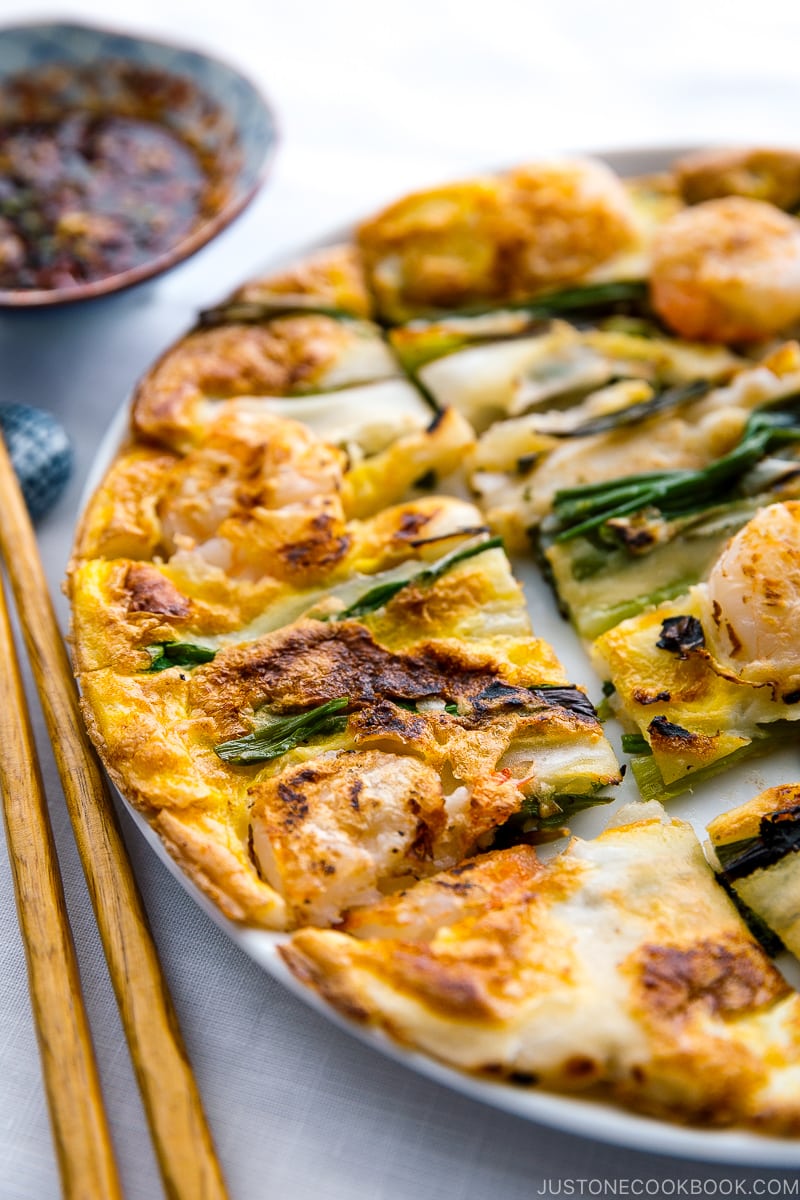
How to Make Korean Pancake (Pajeon)
You can make these pancakes in a total time of just 15 minutes!
- Make the spicy dipping sauce in a small bowl.
- Cut green onions/scallions in half crosswise. If you’re worried about flipping a large pancake, cut the scallions shorter and make smaller pancakes.
- Make the batter. Combine the cake flour and kosher salt in a medium bowl. Slowly pour the cold water and whisk until just combined. It should be thinner than Western-style pancake batter. Do not overmix.
- Heat a nonstick skillet or frying pan over medium-high heat. Add neutral oil. Place scallions on the bottom and shrimp on top.
- Drizzle batter on the scallions and shrimp, just enough to cover.
- Drizzle some beaten egg over the batter. Cook until golden brown, then flip using a large spatula or two spatulas. Flip again when the other side is golden brown. Transfer to a cutting board.
- Cut into squares and serve with spicy dipping sauce.
Keep any leftovers in an airtight container and store in the refrigerator for up to 4 days. It’s so delicious, there probably won’t be any leftovers!
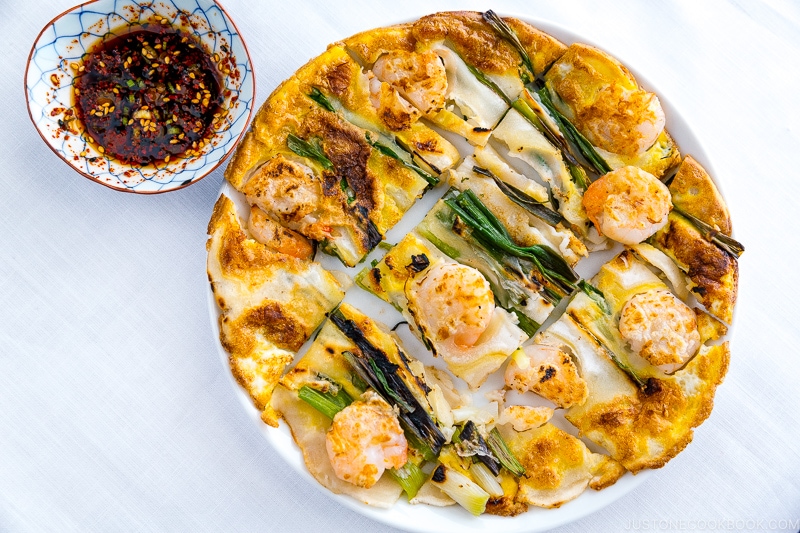
Wish to learn more about Japanese cooking? Sign up for our free newsletter to receive cooking tips & recipe updates! And stay in touch with me on Facebook, Pinterest, YouTube, and Instagram.
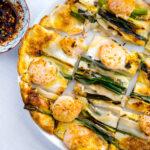
Korean Pancake (Pajeon)
Video
Ingredients
For the Spicy Dipping Sauce
- 1 Tbsp soy sauce
- ½ Tbsp rice vinegar (unseasoned)
- 1 tsp green onions/scallions (thinly sliced)
- ¼ tsp gochugaru (Korean pepper flakes)
- ¼ tsp toasted white and black sesame seeds
- ⅛ tsp sugar (optional, to counter the vinegar‘s acidity)
For the Pancake
- 1 bunch green onions/scallions (about 10 stalks; don’t reduce the amount; use enough to fill the pan so that the pancake holds together when flipped)
- ½ large egg (50 g each w/o shell) (beaten; use half an egg per pancake)
- 1½ Tbsp neutral oil
- 4 oz shrimp (cleaned and deveined)
For the Batter
- ½ cup cake flour (weigh your flour or use the “fluff and sprinkle“ method and level it off; you can make homemade cake flour)
- ½ tsp Diamond Crystal kosher salt
- ½ cup cold water or sparkling water (add slowly as you check the consistency of the batter; you may not need all of it)
Instructions
- Gather all the ingredients. I highly encourage you to weigh your ingredients using a kitchen scale for this recipe. Click on the “Metric“ button at the top of the recipe to convert the ingredient measurements to metric. If you‘re using a cup measurement, please follow the “fluff and sprinkle“ method: Fluff your flour with a spoon, sprinkle the flour into your measuring cup, and level it off. Otherwise, you may scoop more flour than you need.

- Combine all the ingredients for the spicy dipping sauce—1 Tbsp soy sauce, ½ Tbsp rice vinegar (unseasoned), 1 tsp green onions/scallions, ¼ tsp gochugaru (Korean pepper flakes), ¼ tsp toasted white and black sesame seeds, and ⅛ tsp sugar (optional). Set aside.
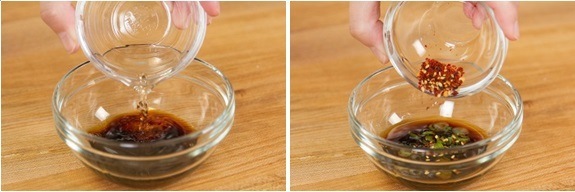
- Cut off the ends of 1 bunch green onions/scallions. Then, cut the scallions in half crosswise. If you’re worried about flipping a large pancake, cut the scallions shorter and make smaller round pancakes so you can easily flip them.

- Beat ½ large egg (50 g each w/o shell) in a small bowl. Set aside half an egg per pancake for cooking.
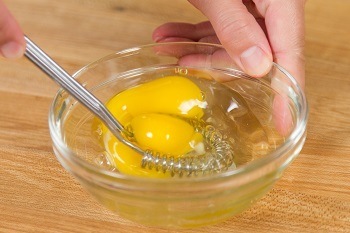
- To make the batter, combine ½ cup cake flour and ½ tsp Diamond Crystal kosher salt in a medium bowl. Slowly add ½ cup cold water or sparkling water (you may not need all of it!) and whisk until just combined. The batter should be thinner than a Western breakfast pancake batter and thicker than a crepe batter. Do not overmix the batter because it’ll create gluten and the pancake won’t have a good texture.

- Place a nonstick frying pan over medium-high heat. When it‘s hot, add 1½ Tbsp neutral oil. Then, spread out the scallions on the bottom of the pan and add 4 oz shrimp on top.

- Drizzle the batter on top to cover the scallions and shrimp. Make sure there is just enough batter between the ingredients so that they will hold together. Take care not to add too much batter, though, or you will end up with doughy pancakes.

- Lightly drizzle the beaten egg (I use half an egg for one pancake) over the batter. Cook for 3 minutes, until the edges of the pancake get crispy and the bottom is golden brown. Flip the pancake using a relatively large spatula or two spatulas, one in each hand. Cook for another 3 minutes, pressing down the pancake with the spatula occasionally, until the pancake is crispy and golden brown. Flip one last time and cook for 30 seconds.

- Transfer the pancake to a cutting board. Cut into small pieces and enjoy with the spicy dipping sauce.
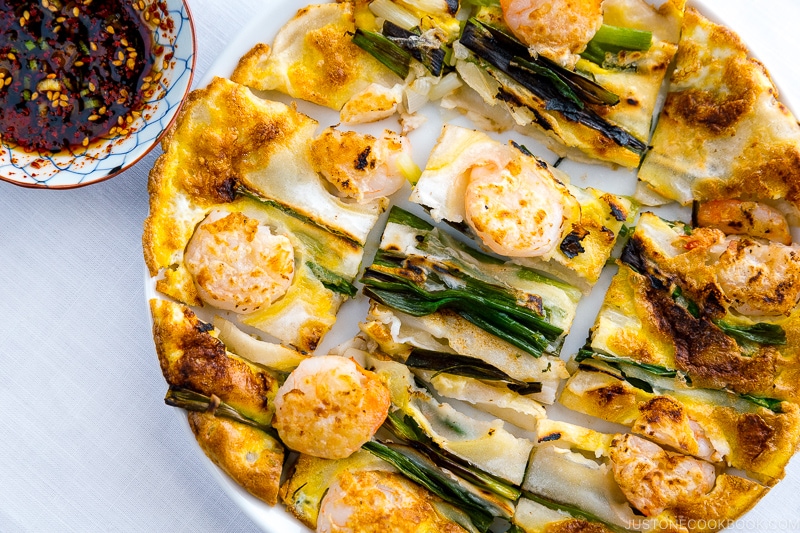
To Store
- You can keep the leftovers in an airtight container and store in the refrigerator for up to 4 days.
Nutrition
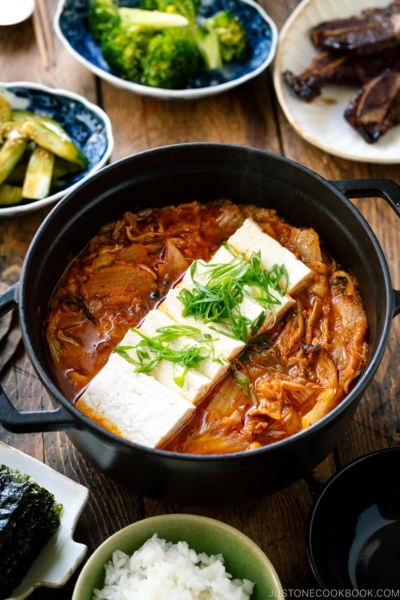
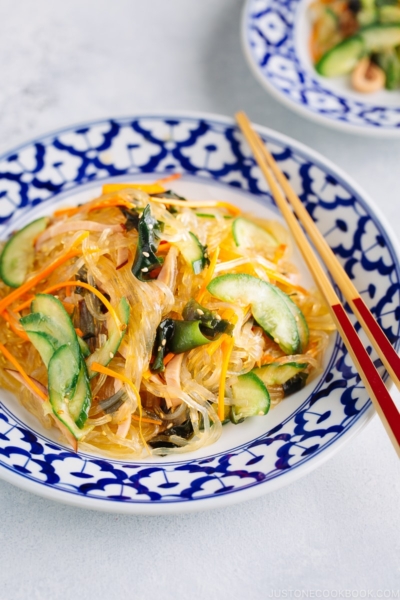
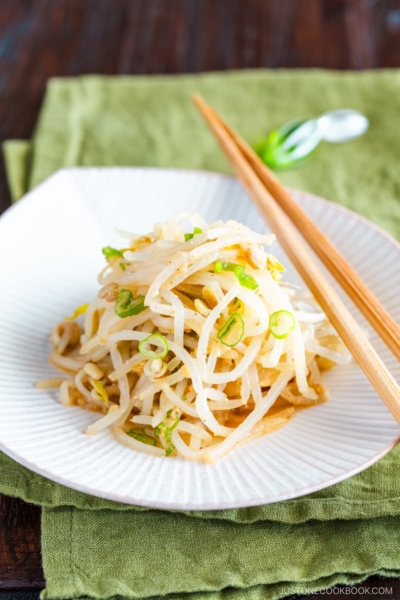
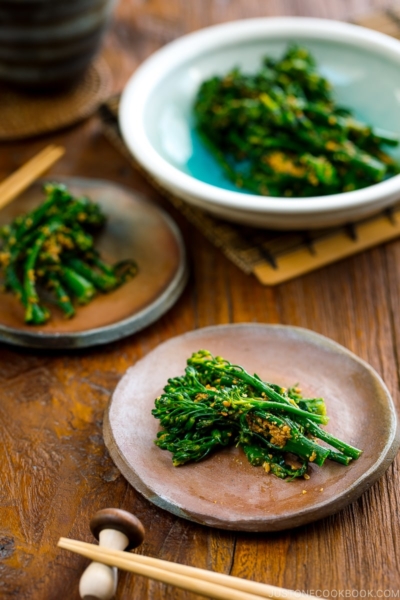





what a great recipe!!! never even thought about this concept! keep these coming… and i’ll keep trying & eating ’em.
Hi Maude! Thank you! Hope you enjoy the recipe!
Just made this tonight; fantastic, even though I had neither cake flour nor corn starch! I did find I had to cook it about 10 minutes before flipping it, but I think my pancake was much thicker than yours. We loved it, though, and will certainly make it again. Thank you!
Hi K! I’m glad to hear you enjoyed this dish! Thank you for your kind feedback! 🙂
This is the best pajeon recipe I’ve tried. The steps separating batter and egg make all the difference. For a gluten free version, you can use brown rice flour to replace the 1 cup cake flour, but must add +2 tablespoons of potato starch (corn starch or arrowroot starch may also work). Add slightly more water to make a thinner crepe.
Hi Irene! I’m so happy to hear you liked this recipe and thanks so much for your kind feedback. 🙂 And thanks for sharing your gluten free version too! That’s very helpful for my readers who need GF version. 🙂
Nice recipe, always a good way to make in a few minutes something delicious 🙂 Make this often after a long working day
Hi Christian! Thanks so much for your kind feedback! Happy to hear you enjoy this recipe. 🙂
I bought a package of pancake flour and the package said its use for pajeon. A lot of Korean ppl use this for pajeon. It’s wheat flour mix with some different veggies n turmeric . Have you tried it?
Hi Teia! Yes, there are pajeon mix available at Asian stores (Korean stores). I’ve tried some brands before and I like some of the brands. 🙂
Very nice and user-friendly recipe and tips, Nami! 🙂 ありがとう & ご苦労様!
Just for fun info: the “pa” 파 in “pa-jeon” 파전 means green onion/ねぎ in Korean, thus why they are so necessary in a pa-jeon! 😀 There are also delicious kimchi-jeon and other types too, made similarly.
Korean language has a lot in common with Japanese (many cognates and very similar grammar structure), and in Korean they do the same as Japanese where the green onion is the “regular” onion, and an extra word must be added to talk about the big round onions. (You know, like just ねぎ is green onion but longer word たまねぎ is big onion. But in English the big one is just “onion” and the ねぎ has the extra word “green onion”, so it’s the opposite for English.) Korean for たまねぎ is “yang-pa” 양파 (literally means “Western onion”)! ^^
Hi Jenny! Thanks so much for the info! どうもありがとう! 🙂
Can’t wait to make it. What other Korean food did you make?
How about Kimchi Fried Rice?
https://www.justonecookbook.com/kimchi-fried-rice/
I searched for Korean pancakes after eating them for the first time in Malaysia(and loving them, obviously!).
I found your recipe, tried it, and I’m in love! This is so good I literally licked my plate after finishing the pancake 🙂 Thanks for providing your readers with such good recipes! You won a new one.
Hi Clara! I’m so glad to hear you enjoyed this recipe! Thanks so much for your kind feedback! 🙂
These look so pretty! Mine never look so pretty. I used sparkling water in my batter last time and it really lightened the batter up!
Hi Sarah! Using a sparkling water is a good idea! I’ll try it next time. Thank you for your advice! 🙂
I love your recipes! Have tried many of them and they all turn out very well! Once I tried another recipe on another site but they are not as easy nor as good as yours.
Thank you for your sharing!
Thank you so much for your kind words, Darrell! I’m so happy to hear that you have tried many of my recipes and thanks for your kind feedback! 🙂
I tried your recipe last night and it is great! It is crispy, yummy and easy to make! Love it!
Aww I’m happy to hear you enjoyed this recipe! Thank you for your kind feedback, Helen! 🙂
great tips you shared. i can’t wait to try!! btw, have you ever tried adding kimchi to the pancake?
Hi Lisa! So sorry I somehow lost your comment in my inbox and completely didn’t realize it till now. Actually, I haven’t!! I’m going to make it very soon. I already know I’ll love it! Thanks so much! 🙂
Hi Nami,
Just wonder can the ALL-PURPOSE flour be substituted by almond flour?
Thanks 🙂
Always love you and your recipes!
Hi Sofie! Thank you! Hmm I have never tried making Korean Pancake with almond flour before. I wish I can tell… Sorry I can’t help. :/
OMG! You are awesome. I’ve just discovered your web site. And I have been here for about 3 hours. I loved your recipes so much. Thank you for your sharing and have a magical days 🙂
Hi Dii! I’m happy to hear you found my site and enjoyed browsing! I hope you found some recipes that you like to try. 🙂 Thanks so much!
This looks amazing! I’ve never eaten these before…will be trying in a few days…can’t wait…Thanks for starting off 2015 with a delicious Bang!
Hi Lyn! I hope you give it a try! It’s pretty addictive. 🙂 Thank you so much for your comment, and Happy New Year!